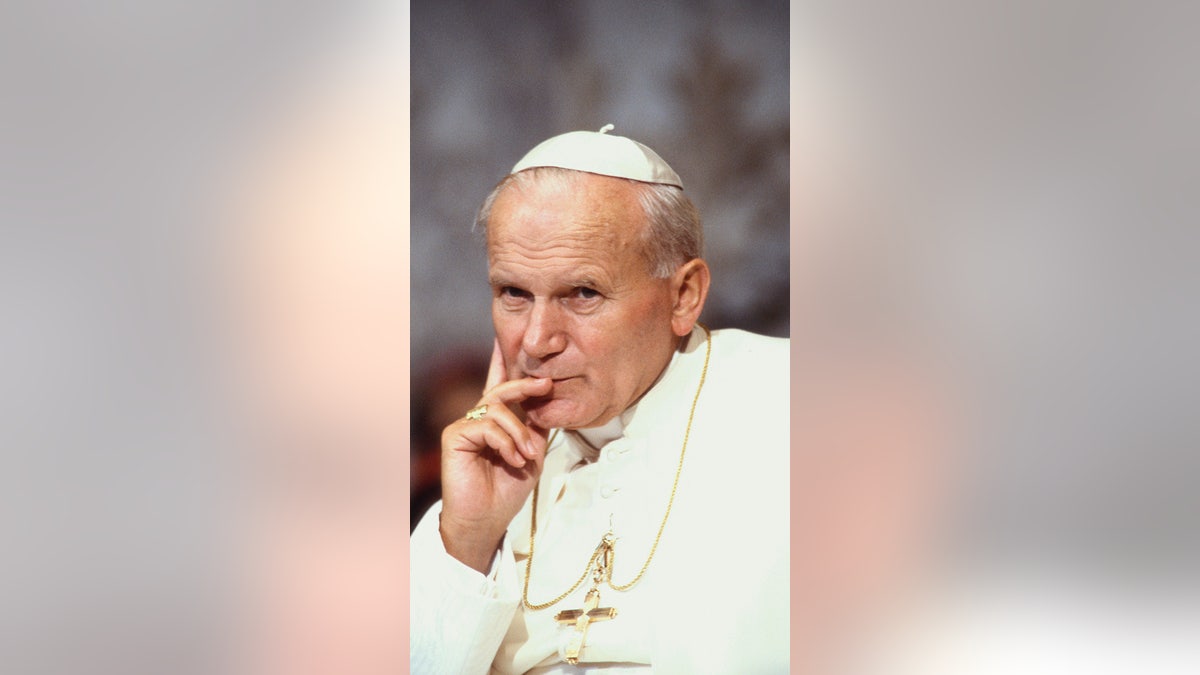On this day in history, September 10, 1987, Pope John Paul II arrives in Miami, is warmly welcomed by Reagans

Pope John Paul II arrived in Miami, Florida, on this day in history, Sept. 10, 1987, to begin a 10-day tour of the United States. He was greeted by President Ronald Reagan and first lady Nancy Reagan as well as thousands of well-wishers.
”I come as a pilgrim, a pilgrim in the cause of justice and peace and human solidarity, striving to build up the one human family,” Pope John Paul said on that day, reading his remarks in English on a stage set under a canopy at Miami International Airport, The New York Times reported.
The cheering audience of thousands waved flags and wore yellow-and-white papal colors.
In his remarks upon the pope’s arrival, President Reagan referenced the Florida heat.
“Today’s Florida sunshine,” Reagan told the pope, “is no warmer than the greeting you will meet in this country,” as multiple sources recounted.
Pope John Paul II (1920-2005) is shown with his arms raised in greeting after a speech at Chapel of St. Patrick’s College, Maynooth, Ireland, October 1979. (Chuck Fishman/Getty Images)
Over the course of his nearly 27-year pontificate, Pope John Paul II would make seven different visits to the U.S. — five of significant length, and two brief stopovers during which he nevertheless left a lasting impression, according to the Catholic News Agency.
While in Miami for the September visit, he marked these events, according to the Archdiocese of Miami:
- Met with representatives of the nation’s priests at St. Martha Church in Miami Shores
- Attended groundbreaking meeting with representatives of the U.S. Jewish community, which began paving the way for the eventual Vatican recognition of the state of Israel
- Paraded down Biscayne Boulevard on his “popemobile”
- Celebrated an outdoor Mass at Tamiami Park that was attended by over 200,000 people. “The Mass was cut short by flashes of lightning and peals of thunder, and the pope finished the celebration in a trailer located behind the massive altar and then came out to bless the persistent few who had waited out the storm,” said the same source.
“The theme of the visit was unity, and Miami’s multiculturalism was on full display, with Cuban flags and Polish Solidarity banners; music in Spanish, Creole, English and Gregorian chant; and the Mass celebrated in three languages,” the Archdiocese of Miami also recounted.

Pope John Paul II, circa 1983, in Milan, Italy. In addition to Miami, the pontiff visited Columbia, South Carolina; New Orleans; San Antonio; Phoenix; Los Angeles; Monterey; San Francisco; and Detroit. (Images Press/IMAGES/Getty Images)
In addition to Miami, the pontiff visited Columbia, South Carolina; New Orleans; San Antonio; Phoenix; Los Angeles; Monterey; San Francisco; and Detroit.
“This trip was the longest of St. John Paul II’s visits to the U.S., and his first to the contiguous West Coast,” noted the Catholic News Agency.
“Miami’s multiculturalism was on full display, with Cuban flags and Polish Solidarity banners; music in Spanish, Creole, English and Gregorian chant; and the Mass celebrated in three languages.”
Notable episodes following his time in Miami included addressing representatives of Black Catholics at the Superdome in New Orleans; attending an ecumenical conference on the University of South Carolina campus; celebrating Mass in San Antonio with about 275,000 in attendance; touring a Catholic hospital and attending the Tekakwitha Conference, a national gathering of Native American Catholics, at the Arizona State Fair Grounds Coliseum in Phoenix; and addressing representatives from the communications industry in Los Angeles, the same source indicated.
Pope John Paul was born in Wadowice, Poland, on May 18, 1920, as Karol Wojtyla.
He was elected pope on Oct. 16, 1978 — and served until his death on April 2, 2005.

Pope John Paul II was born in Wadowice, Poland, on May 18, 1920, as Karol Wojtyla. He was elected pope on Oct. 16, 1978 — and served until his death on April 2, 2005. (Bernard Bisson/Sygma/Getty Images)
He was a pope of many firsts.
He was the first non-Italian pope since the 16th century and the most traveled pope in history. He visited 129 countries, including Cuba and Haiti, the Catholic News Agency indicated.
ON THIS DAY IN HISTORY, APRIL 2, 2005, POPE JOHN PAUL II DIES AT AGE 84
In addition, he was the first pope to visit the White House (1979), the first to travel to the United Kingdom and pray with the Anglican archbishop of Canterbury (1982); the first to visit Egypt and meet with the Coptic pope and the Greek Orthodox Patriarch of Alexandria (2000); the first to visit Greece and pray in a mosque (2001); the first to visit and celebrate Mass at Auschwitz (1979); the first to set foot in a Jewish synagogue since the earliest days of Christianity (Rome, 1986); and the first to pray at the Western Wall during a visit to Jerusalem (2000), according the same source.
Pope John Paul II is remembered for his successful efforts to end communism, as well as for building bridges with peoples of other faiths.
On April 2, 2005, John Paul II, died at his home in the Vatican.
For more Lifestyle articles, visit www.foxnews.com/lifestyle
He was 84.
Six days later, two million people packed Vatican City for his funeral, said History.com.
CLICK HERE TO SIGN UP FOR OUR LIFESTYLE NEWSLETTER
Pope John Paul II is remembered for his successful efforts to end communism, as well as for building bridges with peoples of other faiths, and issuing the Catholic Church’s first apology for its actions during World War II, the same source reported.
CLICK HERE TO GET THE FOX NEWS APP
Pope John Paul was succeeded by Joseph Cardinal Ratzinger, who became Pope Benedict XVI.
Then, Pope Francis succeeded Pope Benedict in March 2013 and canonized John Paul II in April 2014.









